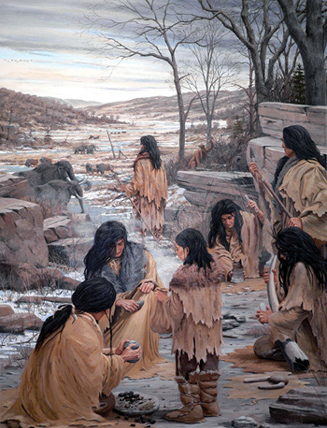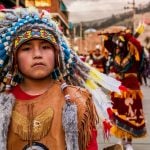Ancient America: 1,500 Years Ago
A thousand years before the Spanish invasion of the Americas began, American Indians were living throughout North America. Furthermore, they had lived on this continent for many thousands of years before this.
There was no single, unified American Indian culture: people adapted to the many different environments of North America in many different ways. One of the technological innovations that began to spread into many parts of North America at this time was the bow and arrow, which was often used alongside the atlatl. Here are some of the events and developments happening circa 500 CE. The names of the archaeological sites mentioned are not the names which Indian people 1,500 year ago used: they are contemporary names given to them by archaeologists and others.
Northwest Coast:
By this time the villages along the Northwest Coast were producing huge food surpluses which allowed for a cultural emphasis on wealth and social stratification. Among these villages was the Makah village of Wa’atch.
On the San Juan Islands in Washington, the era which archaeologists call the San Juan Phase began. This was characterized by a decrease in the number of chipped stone tools. Archaeologists note that the people were not making as many stone tools and that they may have shifted to an even greater dependence on objects made of wood.
At this time, Indian people occupied the English Camp site on the San Juan Islands. Their discarded shells began to form a large midden. The people at this site were building square houses with ridges of shells piled around three of the walls.
Indian people living near the shore on the San Juan Islands were dumping material into the intertidal zone. This dumping was purposeful. It created additional landscape on which to build more houses.
Indian people also occupied the Fossil Bay site on Sucia Island.
California:
Warfare among the Chumash in California seems to have increased. This happened at a time when the bow and arrow were becoming more widely accepted. Some archaeologists have suggested that the bow and arrow may have triggered major changes in the way people interacted with one another. The shift from spears to arrows is very apparent in victims who died after this time.
In California, the Washo began to replace the atlatl and dart with the bow and arrow. They began to use bark slab houses instead of pit houses. Intensive seed gathering and the hunting of small mammals, such as rabbits, became more important than big game hunting.
Also in California, the Costanoan moved into the San Francisco and Monterey Bay areas from the San Joaquin and Sacramento River areas. Linguistic evidence indicates that the Costanoan people were then in contact with speakers of a Hokan language that shared some vocabulary with ancestral Pomoan and Esselen.
In northeastern California Indian people began painting rocks with polychrome designs. The paintings included insects, triangles, zigzags, sun disks, human figures, and some animal figures.
In the Great Basin area of eastern California large village types were developed which appear to have been influenced by the Pueblos in Arizona and New Mexico.
Great Plains:
In the northern Plains area of Alberta and Saskatchewan (Canada), Montana, Wyoming and the Dakotas, hunting technology changed with the adaptation of the bow and arrow which replaced the atlatl.
On the northern Plains, two major Athapaskan migrations occurred about this time. One group went eastward to Hudson Bay (the ancestors of the Sarcee) and the other began a southern migration (the ancestors of the Navajo and Apache.)
In Wyoming, the Indian people at the Wardell Site near present-day Big Piney began using pottery. They were using plainware jars with pointed bottoms.
In Missouri, Indian people at the Zebree site were using primarily wild plant foods. They were, however, raising some sunflowers. In other parts of Missouri, however, Indian people were cultivating a variety of indigenous plants, including maygrass, little barley, sumpweed, and erect knotweed. During this time period, the Native peoples in riverine southeastern Missouri were engaged in a mixed farming economy that included all of the indigenous crop plants but not corn. Wild plant resources remained important food sources.
Plateau:
The Plateau culture area is the region between the Cascade and Rocky Mountains in eastern Washington, northern Idaho, western Montana, southern British Columbia, and northern Oregon.
In southeastern British Columbia and northwestern Montana, the period which archaeologists call the Warex Phase begam. There were two varieties of projectile points (i.e. spear points) which were similar to Plains Avonlea points.
In the southern Plateau area of Washington, Oregon, and Idaho, people began building long houses. These long houses were erected over an excavated area which could be up to one meter deep. The superstructure was a pole frame which was covered with bark and woven reed mats.
In British Columbia, Indian people in the Fraser-Thompson River area were making small carvings in various media. They were making small anthropomorphic and zoomorphic steatite figurines, carved steatite pipes and pendants, small anthropomorphic antler figurines and carved antler hafts.
Southwest:
In the southwest, the Basketmaker people acquired the bow and arrow. This did not replace the atlatl, but was used in addition to it. They also began growing the common brown bean (Phaseolus vulgaris) and cotton. The cotton seeds were used as food. They were also raising domesticated turkeys.
In Arizona, Basketmaker people were now living in the Grand Canyon area.
In Colorado, Indian people began making and using pottery. The pottery tradition seems to have been introduced from the Eastern Woodlands, as it appears first on the eastern prairies and is similar, both stylistically and technically, to Eastern Woodlands pottery.
In Arizona, the Hopi Bear Clan established the village of Shungopavi. Other clans, such as Bluebird and Strap, soon joined the Bear Clan in the village.
In Arizona, the increasing importance of maize agriculture among the Hohokam is seen in the construction of above-ground storerooms, improved pottery, better stone grinding tools, and the increase in the use of irrigation.
In Arizona, the era which archaeologists call the Estrella phase of the Hohokam begins. The phase was marked by red-on-gray pottery which has a thick red line on a gray background. Some of the bowls were decorated by artificially enhancing the grooves between the pottery coils on the outside.
In Arizona, the Hohokam established a small pithouse village in the foothills of the Santa Catalina Mountains at the site of Romero Ruin near present-day Tucson.
In Utah, people from Mesa Verde began to settle in the Hovenweep area.
In New Mexico, Indian farmers in the Upper San Juan area were now making small pottery vessels, effigies, and pipes. While archaeologists consider these people to be Anasazi (Ancestral Puebloan), there may have been some influence from the Mogollon culture. Mogollon culture, however, was 150 miles away.
In New Mexico, a Mogollon pithouse village was established at La Gila Encantada near the present-day city of Silver City. The people were doing some farming as well as hunting big game and gathering piñon nuts.
Southeast:
In Georgia, Indian people built a figure of piled stones near present-day Eatonton. The Rock Eagle Effigy Mound has a wingspread of 120 feet.
In the Upper Apalachicola area of Florida, Indian people were raising corn and squash, but were still relying on gathering wild plants and hunting for most of their subsistence.
Great Lakes Area:
In Western Michigan, the period which archaeologists call the Spring Creek tradition began at the Zemaitis site. At this time the ceramics were fairly thick, cordmarked, and had little decoration.
New England:
In Rhode Island, Indian people constructed a feature on a promontory overlooking an oceanic bay. The feature was a large rectangular enclosure which had a ditch adjacent to a bank of stone and earth. While non-Indian people later named this feature Ninigret’s fort, there is no evidence that any battles were fought here or that it was in fact a defensive structure.
In Vermont, the underground chamber in present-day Putney was in use.




